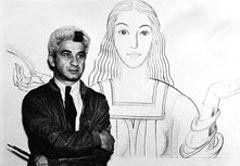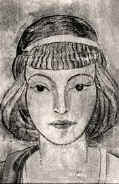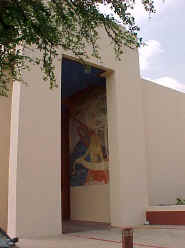October 1999
Historical Information on
Carlo Ciampaglia
and his murals at Fair Park Dallas, Texas
 Born in Italy in 1891, Carlo Ciampaglia came to the United States as a child. Intensely interested in art, many took notice of his young talents. This lead him, eventually, to the opportunity to study drawing at Cooper Union and painting at the National Academy of Design in New York. Interested in his heritage and wanting to see and learn from the masters, Ciampaglia went to Rome to study in his late 20’s. In 1920, while a student in the Italian capital, Ciampaglia won the Prix de Rome which accorded him the chance to study at the American Academy in Rome (with fellow-student George Dahl). This prestigious award provided the support and opportunity to absorb the influence of his native land. During this exciting period of study and intense focus, Ciampaglia was recognized for his talents of applying his knowledge and interest in the old masters to the development of his talents in the modern style of painting, which was so prevalent in Italy (Modernism).
Born in Italy in 1891, Carlo Ciampaglia came to the United States as a child. Intensely interested in art, many took notice of his young talents. This lead him, eventually, to the opportunity to study drawing at Cooper Union and painting at the National Academy of Design in New York. Interested in his heritage and wanting to see and learn from the masters, Ciampaglia went to Rome to study in his late 20’s. In 1920, while a student in the Italian capital, Ciampaglia won the Prix de Rome which accorded him the chance to study at the American Academy in Rome (with fellow-student George Dahl). This prestigious award provided the support and opportunity to absorb the influence of his native land. During this exciting period of study and intense focus, Ciampaglia was recognized for his talents of applying his knowledge and interest in the old masters to the development of his talents in the modern style of painting, which was so prevalent in Italy (Modernism).
Ciampaglia’s first commission after his return to the United States in 1933 was the decoration of a home for Frank Potter in New York. This was followed by other rather diverse design jobs such as the tile decoration of a swimming pool for a hotel in Philadelphia, the mosaic decorations for the chapel of a Mausoleum in Newark, the sketches and color schemes for the Masonic Temple in Scranton, and the painted decorations in the vestibule of the New York home of David Milton, son-in-law of John D. Rockefeller, Jr. His decorative skills were evidently highly regarded, as he was elected an associate member of the National Academy of Design. Ciampaglia maintained studios in New York and at his country estate “Woodpecker Point,” Middle Valley, New Jersey. In 1935, just two years after his return from Italy, he was asked by George Dahl to undertake the Centennial Mural Commission at Fair Park in Dallas, Texas. Ciampaglia arrived in Dallas in February of 1936.
Here are a few details retrieved from the Archives
Telegram: 17 Feb. 1936
“Each one of the subjects has been monumental in character and has had to be developed under the most adverse conditions and under a continuous strain because of the shortness of time. In addition, you have executed 25 or 30 small decorative features, decorative touches and wall ornamentations.”
“I have appreciated immensely the splendid spirit of coop and loyalty you have shown. You have had the happy faculty of inspiring your staff and co-workers with a desire to do a splendid job.”
Letter – 28 July 1936 George Dahl to Carlo Ciampaglia
“Doodles Bug asks about you a lot. Calls you Ciampaglia – you made such an impressions on her. Murals are standing up in fine shape, everyone’s in love with them and I know that you have left your imprint on the community, and that they will be appreciated and enjoyed for many years to come.”
Letter – 26 August 1936 Harry Olmsted to Carlo Ciampaglia
“Re: all the expo has to sell is education and entertainment. Expo owes money to you and others that it cannot pay at this time.”
The Fair Park Murals
 Described as one of the “finest collections of Art Deco buildings in the country”, Fair Park is a product of the 1936 Texas Centennial Celebration. Fair Park represents the epitome of collaborative public art that combined the talents of architects, artists and craftsmen. It is a unique complex of architecture, monumental sculpture and mural paintings. Fair Park has established itself in a long history of other great expositions of the 1930’s still in existence. Its addition to the National Register of Historic Places within the last ten years ranks Fair Park along with the “Alamo” and the “State Capitol” as one of the more significant cultural and historical sites in the State of Texas.
Described as one of the “finest collections of Art Deco buildings in the country”, Fair Park is a product of the 1936 Texas Centennial Celebration. Fair Park represents the epitome of collaborative public art that combined the talents of architects, artists and craftsmen. It is a unique complex of architecture, monumental sculpture and mural paintings. Fair Park has established itself in a long history of other great expositions of the 1930’s still in existence. Its addition to the National Register of Historic Places within the last ten years ranks Fair Park along with the “Alamo” and the “State Capitol” as one of the more significant cultural and historical sites in the State of Texas.
The massive geometric forms of the murals dominate the walls beneath the porticoes of the Centennial Building and the Food and Fiber Building. They provide a colorful counterpoint to the adjacent terracotta walls of the building, drawing the spectator into its more intimate space. The murals of the Centennial Building depict the State’s history as well as its natural and industrial resources. Stylistically they represent a blend of classical, Art Deco and traditional Texas motifs.
 The Centennial Building has 11 different paintings totaling 5550 sq. ft. Their titles are:
The Centennial Building has 11 different paintings totaling 5550 sq. ft. Their titles are:
- Motion
- Traction
- Railroad Transportation
- Navigation
- Future Transportation
- Old Methods of Transportation
- Aero plane Transportation
- Automotive Transportation
Three medallions are painted on the exterior wall surfaces beneath the three South facing porticoes which represent
- Spain 10 dia
- Confederacy 10 dia
- Texas 10 dia
Opposite the Centennial Building across the Esplanade, stands another building which mirrors its image, the Automobile Building which originally had murals painted by another artist under its porticos also. Contemporary newspaper articles describe both sets of murals as being painted in “full rich colors that are associated with Italian art”. Unfortunately the murals were lost when a fire destroyed the building in 1942. It may have been at the time of the reconstruction of this building that the murals on the Centennial Building were painted out so that the two buildings would be mirror images.
Another four murals which total about 1800 sq. ft. are included in this project and are located on the Food and Fiber Building. They are as follows:
Fecundity by Carlo Ciampaglia, located at the West Porch of the Food and Fiber Building
Wheat Harvester by Carlo Ciampaglia, located at the West Porch of the Food and Fiber Building
Pollination of Nature by Carlo Ciampaglia, located in the lunette at the east end of the building
Shaft of Wheat with Cycle and Scythe located in same porch as Pollination of Nature.
The paintings by Ciampaglia located on the Embarcadero Building are still covered over by overpaint. The combination of architecture and murals on these two buildings located next to each other was undoubtedly meant to be a mirror image and therefore a unified concept also.
Over the past fifty years, the murals have been concealed by multiple layers of overpaint. They were thought to be lost until sandblasting of a section of the Centennial building’s exterior revealed a portion of “Motion”.
